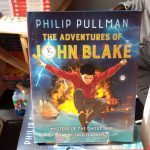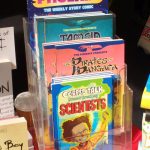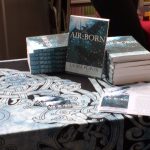 This definitely seems to be my year for having new book related experiences and yesterday I
This definitely seems to be my year for having new book related experiences and yesterday I 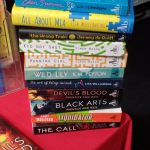 finally attended the Young Adult Literature Convention (YALC) which is now in its 5th year. It is part of the London Film and Comic Con, so there were a lot of people walking around wearing the most amazing and often weird costumes. We had Star Wars, Star Trek, Dr Who, Steam Punk, as well as others that I cannot guess at. However, it was brilliant to see so many enthusiastic and committed fans, all of whom seemed keen to let the world share in their passion. YALC had its own area on the 2nd floor, so that it was a self contained unit. Lots of out favourite YA publishers were there and there were plenty of freebies (in the guise of bookmarks, postcards and even book chapters), some proofs (all gone by the time I arrived) and books at generously reduced prices.
finally attended the Young Adult Literature Convention (YALC) which is now in its 5th year. It is part of the London Film and Comic Con, so there were a lot of people walking around wearing the most amazing and often weird costumes. We had Star Wars, Star Trek, Dr Who, Steam Punk, as well as others that I cannot guess at. However, it was brilliant to see so many enthusiastic and committed fans, all of whom seemed keen to let the world share in their passion. YALC had its own area on the 2nd floor, so that it was a self contained unit. Lots of out favourite YA publishers were there and there were plenty of freebies (in the guise of bookmarks, postcards and even book chapters), some proofs (all gone by the time I arrived) and books at generously reduced prices.
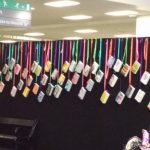 The whole set up was very well organized with a ‘room’ for workshops, a large ‘room’ for talks/panels and masses of space for author signing sessions. It is difficult to describe the
The whole set up was very well organized with a ‘room’ for workshops, a large ‘room’ for talks/panels and masses of space for author signing sessions. It is difficult to describe the 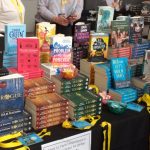 ‘buzz’ that was going on all day, but it was fantastic to see so many young (and not so young) people who obviously love reading these books. Having said all of this I did not feel that the hall was crowded; after seeing tweets from the following two days I am convinced that they were the busiest days. On the plus side it meant that the queues were not too long and people were able to talk to their favourite authors as they enjoyed the activities.
‘buzz’ that was going on all day, but it was fantastic to see so many young (and not so young) people who obviously love reading these books. Having said all of this I did not feel that the hall was crowded; after seeing tweets from the following two days I am convinced that they were the busiest days. On the plus side it meant that the queues were not too long and people were able to talk to their favourite authors as they enjoyed the activities.
I had marked up two panel events that I really wanted to attend and they did not disappoint in any way. The first 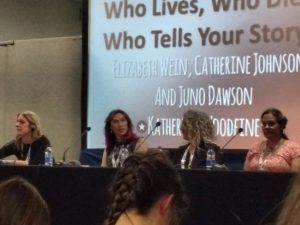 was a discussion about Historical Fiction, something that has been seen as “rather boring” by many in the YA world and yet the panel were totally convinced of the opposite. The chair of the panel was Katherine Woodfine and the members were Juno Dawson, Catherine Johnson and Elizabeth Wein, all of them at the forefront of YA writing today. Their motivation for writing about the past differed, with Elizabeth being inspired to write about young women pilots after she gained her own Private Pilot’s Licence, Catherine wanted to read about people like herself (people of colour) and Juno wanted to look at the lives of LGBT young people in the past. The panel spoke about how they went about the process of writing and specifically about the type of research they undertook. I was particularly impressed by Elizabeth Wein who went “Wing Walking” as part of her research! the panel also discussed what we learn from history and how we need to be skeptical about what we read as history is often ‘whitewashed’. they all have their favourite suggestions for getting the ‘feel’ of the book correct; this includes reading period books to get the language right, Pathe newsreels to hear the voices and see the clothes and early films. Just as with Sci-Fi and Fantasy it is vital that the world building is accurate and feels right to the reader.
was a discussion about Historical Fiction, something that has been seen as “rather boring” by many in the YA world and yet the panel were totally convinced of the opposite. The chair of the panel was Katherine Woodfine and the members were Juno Dawson, Catherine Johnson and Elizabeth Wein, all of them at the forefront of YA writing today. Their motivation for writing about the past differed, with Elizabeth being inspired to write about young women pilots after she gained her own Private Pilot’s Licence, Catherine wanted to read about people like herself (people of colour) and Juno wanted to look at the lives of LGBT young people in the past. The panel spoke about how they went about the process of writing and specifically about the type of research they undertook. I was particularly impressed by Elizabeth Wein who went “Wing Walking” as part of her research! the panel also discussed what we learn from history and how we need to be skeptical about what we read as history is often ‘whitewashed’. they all have their favourite suggestions for getting the ‘feel’ of the book correct; this includes reading period books to get the language right, Pathe newsreels to hear the voices and see the clothes and early films. Just as with Sci-Fi and Fantasy it is vital that the world building is accurate and feels right to the reader.
I found that I had time before my final session so I treated myself to a panel talking about writing “Thrillers”. the  panel was a large and well respected one including Sophie McKenzie, Teri Terry, Matthew Crow, Karen M McManus and Emily Barr. there was a long discussion about what people used as their main focus; for some it was about the place and going somewhere very different, whilst others tended to use locations that they were very familiar with and which the readers learn to relate to. Everyone agreed about the vital importance of characterization with “People in conflict with others and themselves”. The readers are often in the 12-14 age group and they are also going through great changes in their lives. Overall this was a very stimulating session which I thoroughly enjoyed.
panel was a large and well respected one including Sophie McKenzie, Teri Terry, Matthew Crow, Karen M McManus and Emily Barr. there was a long discussion about what people used as their main focus; for some it was about the place and going somewhere very different, whilst others tended to use locations that they were very familiar with and which the readers learn to relate to. Everyone agreed about the vital importance of characterization with “People in conflict with others and themselves”. The readers are often in the 12-14 age group and they are also going through great changes in their lives. Overall this was a very stimulating session which I thoroughly enjoyed.
My final session was one that I thought might teach me something about a TV series that I only seemed to watch the 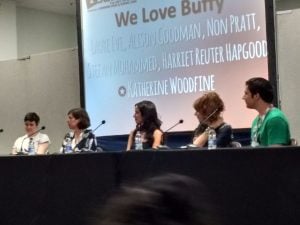 trailers for, it was called “We love Buffy” and was for real aficionados of “Buffy the Vampire Slayer. I was totally amazed by the knowledge that these people had about the show. They knew the names of the episodes, the characters, the songs; it was incredible. The panel consisted of Katherine Woodfine, Laure Eve, Alison Goodman, Non Pratt, Harriet Reuter Hapgood and Stefan Mohammed and their experience of the series was quite wide ranging, in line with the variations in their ages. Some had watched as children and teens, whilst others had been adults. This meant that their understanding and fear levels were very variable, but they had all been totally sucked into the series and till had that enthusiasm that denotes a true fan. Everyone had their favourite characters, although whenever someone else was mentioned you could hear the mental re-assessment ; however they did agree that “Giles is the world’s coolest librarian” and who am I to disagree with that.
trailers for, it was called “We love Buffy” and was for real aficionados of “Buffy the Vampire Slayer. I was totally amazed by the knowledge that these people had about the show. They knew the names of the episodes, the characters, the songs; it was incredible. The panel consisted of Katherine Woodfine, Laure Eve, Alison Goodman, Non Pratt, Harriet Reuter Hapgood and Stefan Mohammed and their experience of the series was quite wide ranging, in line with the variations in their ages. Some had watched as children and teens, whilst others had been adults. This meant that their understanding and fear levels were very variable, but they had all been totally sucked into the series and till had that enthusiasm that denotes a true fan. Everyone had their favourite characters, although whenever someone else was mentioned you could hear the mental re-assessment ; however they did agree that “Giles is the world’s coolest librarian” and who am I to disagree with that.
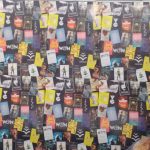
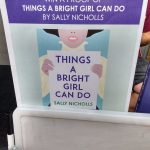
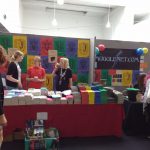
This had proved to be a fantastic experience meeting friends, listening to fantastic authors and generally wallowing in the world of YA books. I definitely feel that I will be back next year and maybe I will include the Saturday as it seemed fabulous on Twitter.
Meanwhile I have a lot of reading to catch up on ready for the next set of blog posts on a wide range of books.
